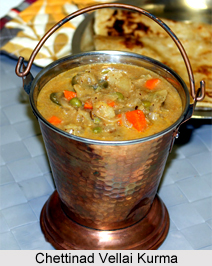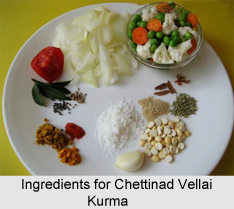 Chettinad Vellai Kurma is a famous curry which is part of the Chettinad cuisine. "Navratan Kurma" is a variation in which specifically 9 chosen vegetables are added to make the dish. It is a rich and creamy curry with a mild flavor of spices. Chettinad Vellai Kurma can be commonly seen paired up with tiffin items like "Chapati", "Paratha", "Idiyappam" and "Appam" in restaurants. Like in any other cuisine, mixed vegetable curry or Kurma has a significant place in Chettinad cuisine too. In every house this will be a sure item cooked though different recipes followed. The Chettinad masala adds to the taste of the curry and makes it a special item. One can make the kurma with any vegetables of choice.
Chettinad Vellai Kurma is a famous curry which is part of the Chettinad cuisine. "Navratan Kurma" is a variation in which specifically 9 chosen vegetables are added to make the dish. It is a rich and creamy curry with a mild flavor of spices. Chettinad Vellai Kurma can be commonly seen paired up with tiffin items like "Chapati", "Paratha", "Idiyappam" and "Appam" in restaurants. Like in any other cuisine, mixed vegetable curry or Kurma has a significant place in Chettinad cuisine too. In every house this will be a sure item cooked though different recipes followed. The Chettinad masala adds to the taste of the curry and makes it a special item. One can make the kurma with any vegetables of choice.
Ingredients:
•Onions - 2, chopped
•Tomato - 1, chopped
•Potato - 1, cut into pieces
•Carrot - 1, cut pieces
•Green Peas - 3 tbsp
•Pumpkin - 1 cup
•Brinjal - 1, cut into pieces
•Cooked Beans - 2 tsp
•Green Chillies - 5
•Bay Leaves - 2
•Dalia Flour - 1 tsp
•Fresh Grated Coconut - 3 tsp
•Ginger-Garlic Paste - 1/2 tsp
•Garam Masala - 1/2 tsp
•Curd - 1 cup
•Cumin Seeds - 1/2 tsp
•Fennel Seeds - 1/2 tsp
•Cashews - 10
•Turmeric Powder - 1/2 tsp
•Coriander Powder – 2 tsp
•Salt to taste
•Ghee - 1 tbsp
•Oil - 3 tbsp
•Curry Leaves - 5 to 6
•Coriander Leaves - 2 tbsp, finely chopped (for garnishing)
•Coconut Oil - 1 tsp, for garnishing
Method:
1. Take a bowl and grind grated coconut, dalia flour, cashews and curd in it to make a smooth paste. Keep it aside.
2. Soak the beans and cook it in pressure cooker till it becomes tender. Keep it aside.
3. Take a pan and heat oil and ghee in it.
4. Put cumin seeds fennel seeds and curry leaves in it.
5. When the seeds start to crackle, put bay leaves, chopped onions and green chillies in it. Fry well.
6. When the onion is translucent, put ginger-garlic paste in it and saute it till it looses its raw smell. Mix it for few more minutes.
7. Put chopped tomato in it and saute again. Add carrot, cooked beans, potato, brinjal, green peas and pumpkin in it along with turmeric and coriander powder and saute it for few more minutes.
8. Add 2 cups of water to this mixture. Cover it and cook it for 10 minutes on medium flame.
9. Now, add the prepared coconut-curd paste along with garam masala and salt in it and let it cook for 5 minutes.
10. Sprinkle coconut oil on it and garnish with coriander leaves. Serve hot with "Idlis".
Notes for Chettinad Vellai Kurma
While switching off make sure that the kurma is not very thick. It will thicken once it cools. The masala items that have to be grinded must be roasted in oil before grinding to increase the taste.




















